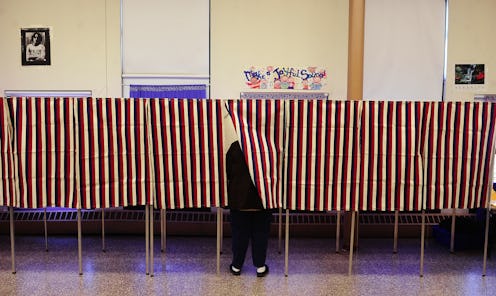News
Here's How Many People Might Vote On Super Tuesday
Unless you believe in fortune-tellers and find one who's really into the 2016 presidential primary race, you're not going to find an exact prediction on how many people will vote on Super Tuesday, March 1. What we do know for sure is that 12 states, plus American Samoa, are holding contests on the big day. Ten states are holding primaries or caucuses for both parties; American Samoa and Colorado are only holding Democratic caucuses, and Alaska will have its Republican caucuses. Though we can't know for sure how many people will turn out to vote, we can look at past turnout rates for the states participating in Super Tuesday this year, along with trends in turnout this year thus far for clues.
The most recent election in 2012 only involved a primary race for Republicans, since President Barack Obama ran unopposed on the Democratic ticket. Voters' attitudes toward Obama could have resulted in larger or smaller turnout in 2012 on the Republican side, so let's look at the last year when candidates from both parties were competing: 2008. For this, the United States Elections Project will be a handy resource. (I won't bore you with the state-by-state breakdown; if you want to check for yourself, you can add up the numbers for Alabama, Alaska, American Samoa, Arkansas, Colorado, Georgia, Massachusetts, Minnesota, Oklahoma, Tennessee, Texas, Vermont, and Virginia.)
Adding up the 2008 voter turnout for all of 2016's Super Tuesday states — accounting for the fact that three places are only holding one party contest — leaves us with 13,678,085 total votes cast. That doesn't include American Samoa; a New York Times article from 2008, quoting the Associated Press, reported that 285 voters turned out for the Democratic caucus there, a record for the territory. That bumps our grand total up to 13,678,370.
If voters in this year's Super Tuesday roughly follow 2008's turnout rates, then we can expect over 13 million votes to be cast that day. But if the contests that have already taken place in 2016 are indicative of Super Tuesday's turnout, then we might expect something different. According to Vox, Democratic turnout in Iowa, New Hampshire, and Nevada was down about 23 percent in 2016 compared to 2008's figures. On the other hand, Republican turnout has been breaking records left and right. For example, Iowa's 2008 Republican turnout was 118,696 compared to 2016's 186,874, according to United States Elections Project data; that's about a 60 percent increase. There was a more modest increase of about 18 percent in New Hampshire, but about 70 percent in Nevada, and about 65 percent in South Carolina.
We also need to take into consideration that, in 2008, Democratic turnout was way higher than Republican turnout in most states, sometimes twice as high. So, while a 23 percent drop in Democratic participation could lead to overall lower turnout, if Republicans keep breaking records with 60 to 70 percent increases on the regular in 2016, the number could even out or exceed past overall turnout. Fortunately, you have time to rest from all these numbers before Super Tuesday, when the percentages will be flying in from every direction.
Believe it or not, both primaries and caucuses can be laugh-out-loud hilarious. Don't believe us? Have a listen to Bustle's "The Chat Room" podcast...
Image: Caroline Wurtzel/Bustle
